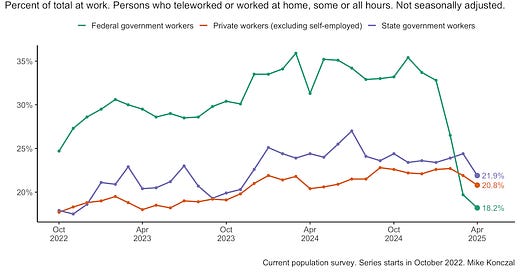Federal Employees Are Now Less Likely to Work from Home Than Private Sector Workers
New evidence from the latest jobs report shows Trump’s DOGE cuts and efforts finally showed up somewhere visible: in the share of federal workers that telework.
So far, we haven’t seen much tangible impact from the Department of Government Efficiency (DOGE) in the hard economic data. Their claimed savings haven't materialized in federal spending figures, which isn't surprising given their inability to clearly document where those savings might be coming from.
But today’s jobs numbers give a hint of something concrete. It’s not just that federal government employment is down by about 26,000 workers since January, roughly 0.8 percent of the federal workforce, and far below what they have promised. Rather, it's in the details about remote work. As Figure 1 shows, federal workers are now less likely to work from home the private sector:
This was very much not the case before, where federal workers were much more likely. Since October 2022, the Bureau of Labor Statistics (BLS) Current Population Survey, which gives us the unemployment rate, has included questions about teleworking, including hours worked remotely. While monthly numbers have some volatility and aren't seasonally adjusted, a downward plunge for federal workers clearly happened after President Trump took office, pushing federal remote work below the private sector after being elevated.
Figure 1 also compares to state workers to give some public sector comparison. There’s no comparable collapse in state government teleworking, so this fall is isolated to the federal government. (Local government workers, who are going to include a lot of police and teachers, have teleworking rates around 10 percent, and they also haven’t recently fallen.)
There’s a lot of ways to slice the BLS data on working from home, and you can find detailed series numbers and spreadsheets here from the BLS. One thing to check is whether this from workers who were entirely remote in their jobs or not. And Figure 2 shows that its is both.
I noticed this last month but wanted a second month of data before flagging, and here it is. Hours teleworking for those who do telework look steady, implying these “savings” is more on the extensive rather than intensive margins - some Federal workers are cut off entirely from this benefit. Though I think that needs more data and investigation.
If you look at Figure 1 back above, you can see that private sector workers share of remote work is actually higher than it was at this time in 2023. Let’s take a three-month average across industries, and see how much it’s changed across two years in Figure 3.
I was surprised by this and you might be as well. I’ll throw a giant facet wrap into the footnotes so you can see yourself.1 There is a significant amount of debate on the best ways to measure these rates. But however you slice it, the BLS has been consistent for two and a half years now, showing telecommuting slowly rising in the private sector.
Which makes perfect sense. Polling consistently shows remote work is a highly valued amenity. It helps workers manage family life and provides crucial flexibility. And firms have spent the past few years integrating this benefit into their pay structure.2
In contrast, DOGE's aggressive rollback of telecommuting for federal employees isn’t actually saving significant money. Instead, it's precisely the kind of cut that weakens state capacity in the long-term. This is consistent with other things they are doing. The Institute for Macroeconomic & Policy Analysis (IMPA) recently found that “A 25 percent cut in R&D would decrease revenue by approximately 4.3 percent annually, while a 50 percent cut would decrease it by 8.6 percent annually.” (New York Times coverage of the report here.) Which gives a baseline scale for the long-term damages.
I understand government workers and working from home isn’t the most sympathetic cause. (Though the supposedly "pro-natalist" Trump and Musk attacking this pro-family amenity in both the public and private sectors shows how shallow that commitment to families actually is.) But it’s less about sympathy and more about competency. Government work has been low-pay but good benefits and high stability. Replacing it on the fly with low-pay and high instability mean eventually we won't just have fewer federal employees. We'll have a federal government that's less capable, less effective, and ironically, far less efficient.
I think an important and less discussed aspect of the labor market convulsions from 2021-2023 was working this brand new “working from home” amenity at scales into employment. I think it explains why peer countries experienced a giant circular shift in the Beveridge Curve, and has some elegant modeling in the paper Job Amenity Shocks and Labor Reallocation by Sadhika Bagga, Lukas Mann, Aysegül Sahin, and Giovanni L. Violante (Bagga et al 2024).
If true, part of the reason for more negative real wage growth at the top of the income distribution was that workers were being “paid” by getting to work from home. This argument doesn’t have many friends in the commentary and my understanding is people are still fighting on the metrics. But it would help explain several puzzling economic dynamics.








